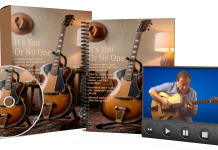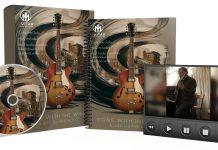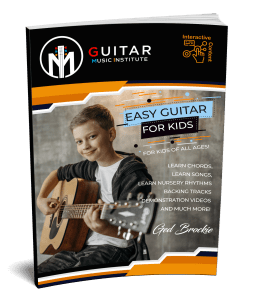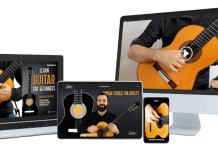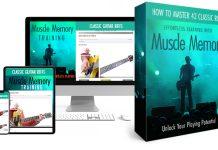This post may contain affiliate links. As an Amazon associate, Google associate as well as associate for other programs, Guitar & Music Institute may earn commissions from qualifying purchases.

Shopping for your first guitar can be an exciting yet overwhelming experience. With so many options available, it’s important to have a clear understanding of what to look for when making this important purchase. In this beginner’s guide, we will provide you with essential tips and recommendations to help you navigate the world of guitars and find the perfect instrument to start your musical journey.
Key Takeaways:
- Follow this beginner guitar buying guide to make an informed decision when purchasing your first guitar.
- Consider factors such as your preferred music genre, playability, and budget when choosing between an electric or acoustic guitar.
- Pay attention to the quality, playability, and sound characteristics of the guitar you intend to buy.
- Decide whether to buy a new or used guitar based on your preferences and budget.
- Choose the right guitar size that offers comfort and ease of playing.
Electric Guitar vs. Acoustic Guitar for Beginners
When it comes to buying your first guitar, you’ll need to decide between an electric guitar or an acoustic guitar. Both options have their unique qualities and cater to different musical genres, so it’s essential to choose the one that aligns with your preferences and goals.
If you’re drawn to the sounds of rock, metal, pop, or other genres that require versatility and a wide range of sounds, an electric guitar may be the right choice for you. Electric guitars have the advantage of being able to produce various tones and effects, thanks to their ability to be connected to amplifiers and other electronic devices. They’re often favored by musicians who love experimenting with different soundscapes and effects.
On the other hand, if you’re more inclined towards folk, country, or singer-songwriter music, an acoustic guitar may be the perfect fit. Acoustic guitars provide a natural and unplugged sound, making them popular for intimate solo performances or acoustic jam sessions. The warm and resonant tones produced by acoustic guitars can create a captivating and soulful atmosphere.
Consider your preferred music genre and the type of sound you want to achieve when making your decision. It’s important to choose a guitar that resonates with your musical preferences and inspires you to play.
Check out our latest book from the GMI Guitar Shop for beginners! Click the image to find out more.
Pros and Cons of Electric Guitar
- Pros: Versatile sound options, ability to experiment with effects, suitable for various genres, wide range of styles and designs
- Cons: Requires additional equipment (amplifiers, cables), potentially higher costs, steeper learning curve for beginners
Pros and Cons of Acoustic Guitar
- Pros: Natural and unplugged sound, beginner-friendly, portable, lower initial investment, no additional equipment necessary
- Cons: Limited sound options, less versatility in terms of genre, may require more finger strength for certain playing techniques
Ultimately, the decision between an electric guitar and an acoustic guitar should be based on your musical preferences, the genre you want to pursue, and the style of sound you desire. Both types of guitars offer unique advantages and can be equally rewarding for beginners. Take the time to explore different models, play them if possible, and choose the guitar that sparks your passion for music.
What to Look for When Buying a Guitar
Before making a purchase, it’s important to consider certain factors. These factors will help you make an informed decision and ensure that you choose a guitar that meets your needs and preferences. Here’s a checklist of what to look for when buying a guitar:
- Guitar Quality: Examine the overall build quality of the guitar. Look for any visible defects or signs of poor craftsmanship. A high-quality guitar will have solid construction and durable materials.
- Guitar Features: Consider the features of the guitar that are important to you. This could include the type of wood used, the type of pickups (if it’s an electric guitar), the number of frets, and any additional controls or switches.
- Guitar Playability: Test the playability of the guitar. Check if the neck is comfortable to hold and if it allows for easy access to all of the frets. Evaluate the action (string height) and determine if it suits your playing style.
- Guitar Sound: Listen to the guitar’s sound and determine if it matches your desired tone. Pay attention to the resonance, sustain, and overall character of the sound. Keep in mind that the sound can also be influenced by your choice of amplifier (if it’s an electric guitar).
- Guitar Tuning Stability: Check if the guitar stays in tune. Play some chords and listen for any noticeable tuning issues. A guitar with good tuning stability will allow you to play for longer periods without constant retuning.
- Guitar Electronics (if applicable): If you’re considering an electric guitar, test the electronics. Make sure the pickups, switches, and volume/tone controls are functioning properly.
Considering these factors will help you find a guitar that not only sounds great but also feels comfortable to play. Take your time to try out different guitars and compare their features before making a decision. By doing so, you’ll be one step closer to finding the perfect guitar for your musical journey.
New vs. Used Guitars
When it comes to buying your first guitar, one of the decisions you’ll need to make is whether to purchase a new or used instrument. Each option has its own advantages and considerations to keep in mind.
Advantages of Buying a New Guitar
- A new guitar comes with the latest technology and features, ensuring that you have access to the most up-to-date advancements in guitar design.
- You’ll also receive a manufacturer’s warranty, providing peace of mind in case of any defects or issues.
- A new guitar offers a fresh, pristine look, allowing you to truly make it your own.
Advantages of Buying a Used Guitar
- Used guitars can offer a unique vintage aesthetic, which some players find appealing.
- They may also produce a seasoned, well-played sound that adds character to your music.
- Used guitars are often priced lower than new ones, making them a more affordable option for those on a budget.
- You may have the opportunity to find discontinued models or limited editions that are no longer available in stores.
While there are advantages to both new and used guitars, it’s important to consider a few things when buying a used instrument. First, carefully assess the condition of the guitar, looking for any signs of wear, damage, or needed repairs. Second, consider the budget you have available and whether a new or used guitar aligns with your financial goals.
Ultimately, the decision between a new and used guitar depends on your personal preferences, budget, and the specific characteristics you value in an instrument. By carefully considering these factors, you can make an informed choice that suits your needs and enhances your guitar-playing experience.
Selecting the Right Guitar Size
Choosing the right guitar size is crucial for comfort and ease of playing. Whether you’re a beginner or an experienced guitarist, finding a guitar that fits your body and playing style is essential. While electric guitars generally have standard sizes suitable for most players, acoustic guitars come in various sizes to accommodate different age groups and heights. To ensure a comfortable playing experience, consider the player’s age, height, and comfort when selecting the guitar size.
For adult beginners and taller individuals, a full-size acoustic guitar is usually the best option. These guitars offer a standard length and width that can accommodate most adult players. If you have smaller hands or prefer a more compact instrument, you can consider a 3/4 size or 1/2 size guitar. These smaller sizes are also suitable for teenagers and older children.
For younger children, there are specially designed guitars with smaller bodies and necks to provide a comfortable playing experience. These child-sized guitars allow young players to learn and enjoy the guitar without straining their hands or bodies. It’s important to choose a size that allows the child to hold and play the guitar comfortably.
Remember, selecting the right guitar size is not only about physical comfort but also about ensuring proper technique and ease of playing. Finding the right fit will greatly enhance your playing experience and enable you to progress more effectively. Take the time to try out different sizes and consult a knowledgeable salesperson or teacher if needed.
Check out the guitar size chart below to get a visual representation of the different guitar sizes:
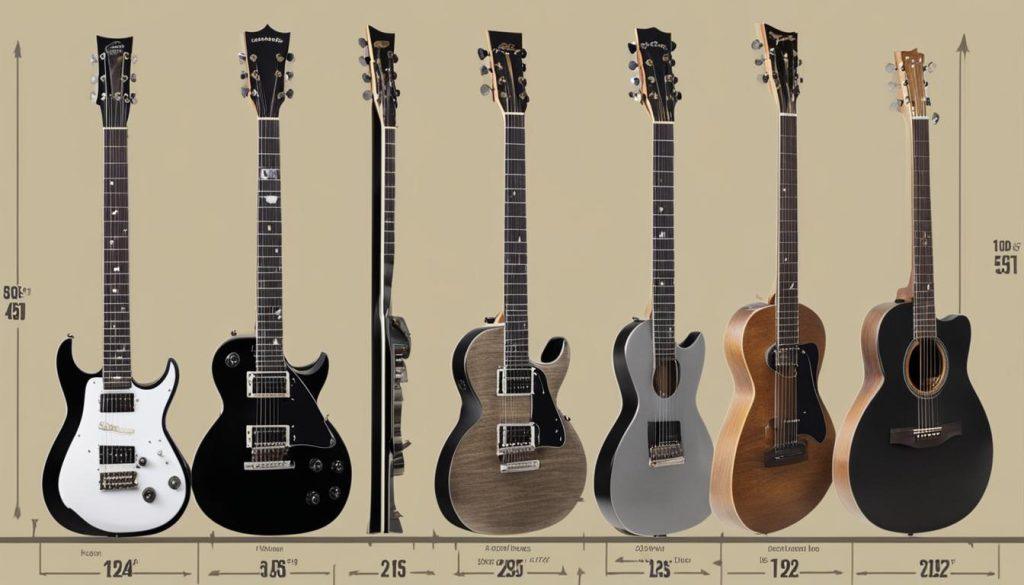
Next, we will explore some of the best guitar brands for beginners, helping you make an informed decision on which brand to choose for your first guitar.
Best Guitar Brands for Beginners
When it comes to choosing the perfect guitar as a beginner, it’s important to consider reliable and beginner-friendly guitar brands. These brands are known for producing high-quality instruments with good playability and sound quality, setting the stage for a great learning experience.
Here are some of the top guitar brands for beginners:
- Fender: Fender is a renowned name in the guitar industry, offering a wide range of electric and acoustic guitars suitable for beginners. Their models are known for their reliability and iconic design, making them a favorite among guitarists.
- Epiphone: Epiphone is recognized for their affordable yet well-built guitars. They are owned by Gibson and offer a variety of electric and acoustic models, providing beginners with excellent options to explore.
- Yamaha: Yamaha is a trusted brand that caters to the needs of both beginner and advanced players. Their guitars deliver reliable performance and are known for their durability, making them a popular choice for beginners.
- Ibanez: Ibanez guitars are highly regarded for their playability and versatility. They are known for producing solid-body electric guitars that are suitable for various music genres, especially rock and metal.
- EastCoast: EastCoast guitars offer affordable options with great value for beginners. Their instruments are well-crafted and provide excellent sound quality, allowing beginners to explore their musical skills without breaking the bank.
These are just a few examples of the best guitar brands for beginners. When considering a guitar, take into account your specific needs, preferences, and budget. Remember, finding a guitar that feels comfortable to play and inspires you is key to your success as a beginner guitarist.
Where to Buy a Guitar
When it comes to buying a guitar, you have options like local music stores and online guitar stores. Both options offer their own advantages, so it’s important to weigh them against your specific needs and preferences.
Local Music Stores
Local music stores provide a unique shopping experience as you can try out the guitar before making a purchase. This allows you to feel the instrument in your hands, test its playability, and get a sense of its sound. You can also seek personalized assistance from knowledgeable staff who can help guide you in finding the right guitar for your needs.
Visiting a local music store also gives you the opportunity to form a connection with the store and its staff. They can become a valuable resource for any future questions or assistance you may need as you continue your musical journey.
Online Guitar Stores
Online guitar stores offer convenience and a wide selection of instruments. You can browse through an extensive range of guitars from the comfort of your own home, making it easier to compare models, brands, and prices.
Online guitar stores often feature detailed product descriptions and customer reviews, which can help you make an informed decision. You can also take advantage of online demos and videos that showcase the sound and features of different guitars.
Furthermore, online guitar stores often have competitive pricing and may offer discounts or special promotions. They usually have customer-friendly return policies, allowing you to return or exchange the guitar if you’re not satisfied with your purchase.
Whether you choose to buy from a local music store or an online guitar store, consider factors such as customer service, return policies, pricing, and the overall shopping experience. Ultimately, the most important thing is to find a reputable retailer that meets your specific needs and provides the guitar you’ve been dreaming of.
Guitar Accessories for Beginners
Along with your guitar, there are essential accessories that every beginner should consider. These accessories will help you maintain your guitar and enhance your playing experience.
1. Extra Guitar Strings
Having extra guitar strings is crucial for beginners. Strings can break during practice or performance, and having backups ensures that you can continue playing without interruption. Consider purchasing a set of strings suitable for your guitar’s type and gauge.
2. Guitar Picks
Guitar picks, also known as plectrums, are small, triangular-shaped tools used to strum or pluck the strings. They provide a different tone and attack compared to playing with your fingers. Experiment with different pick materials (such as plastic, nylon, or metal) and thicknesses to find the one that suits your playing style.
3. Guitar Tuner
To ensure your guitar sounds its best, a guitar tuner is essential. Tuning your guitar regularly keeps it in proper pitch and allows you to play chords and melodies correctly. Use a clip-on tuner or a smartphone app to help you tune your instrument accurately.
4. Guitar Case
A guitar case is vital for protecting your instrument from damage during transportation and storage. Whether you opt for a gig bag or a hardshell case, make sure it fits your guitar and provides adequate padding and support.
These essential guitar accessories for beginners will assist you in maintaining your instrument’s condition and optimize your practice sessions. They are readily available at music stores or online retailers, so start building your collection today!
Choosing the Right Guitar for a Beginner
When it comes to buying your first guitar, it’s important to choose one that matches your playing style, preferences, and inspires you to practice. By considering a few key factors, you can find the perfect instrument to kick-start your musical journey.
Consider Your Favorite Genres
Think about the genres of music you love to play. Each type of guitar has its own unique sound that may be more suitable for certain genres. For example, if you’re into rock or metal, an electric guitar may be the right choice. On the other hand, if you prefer folk or acoustic-based music, an acoustic guitar would be a great fit. Matching the guitar to your favorite genres will enhance your playing experience.
Take Aesthetics into Account
Not only should your guitar sound great, but it should also look great to you. Consider the visual appeal of the instrument. Do you prefer a classic vintage look or a modern design? Finding a guitar that matches your personal aesthetics will make you more excited about playing and picking up the instrument.
Think About Comfort
Comfort is a crucial factor when choosing a beginner guitar. Pay attention to the guitar’s weight, shape, and neck width. Hold the guitar in your hands and feel if it’s comfortable to play. Remember, you’ll be spending a lot of time practicing, so it’s important that the instrument feels right to you.
Stay Within Your Budget
Before embarking on your guitar-buying journey, set a budget for yourself. Guitars come in a wide range of prices, so it’s essential to know how much you’re willing to spend. While expensive guitars often offer better quality and sound, there are plenty of affordable options available for beginners. Find the balance between your budget and the overall quality of the instrument.
Choosing the right guitar is an exciting process that should be tailored to your individual needs and preferences. Consider your favorite genres, aesthetics, comfort, and budget when making your decision. Remember, the perfect guitar is the one that makes you excited to pick it up and play. So go out there, explore your options, and find the guitar that will accompany you on your musical journey.
Tips for Buying a Guitar for a Child
When it comes to buying a guitar for a child, there are a few important considerations to keep in mind. Children have smaller hands and bodies, so it’s essential to find a guitar that is suitable for their age and size.
One option to consider is child-sized guitars. These guitars are designed specifically for young players, with smaller necks and fretboards that make it easier for children to reach the strings and form chords. Choosing a guitar that is the appropriate size will ensure your child feels comfortable while playing, allowing them to focus on learning and enjoying the instrument.
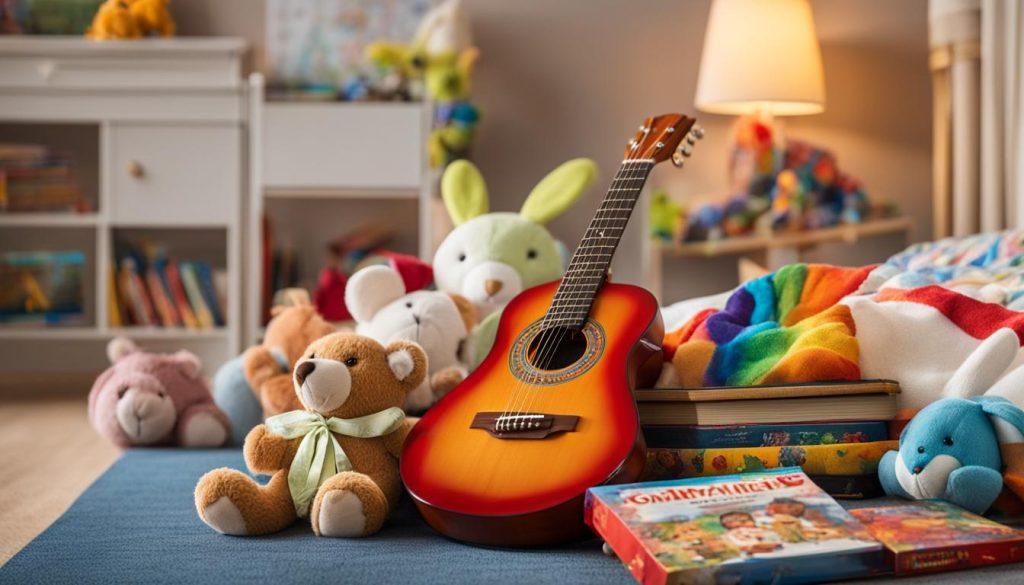
Another factor to consider is the type of strings on the guitar. For young children, nylon-string guitars are often recommended. Nylon strings are softer and easier on the fingers, making it more comfortable for kids to press down and play. This can help prevent discouragement or discomfort that can arise from using steel strings, which are typically found on adult-sized guitars.
When selecting a guitar for your child, involving them in the process can make it more enjoyable and encourage their interest in playing. Take the time to listen to their preferences and musical interests, and let them choose a guitar that they connect with. This can help foster their love for music and create a positive learning environment.
Tips for Buying a Guitar for a Child:
- Choose a child-sized guitar with a smaller neck and fretboard for ease of play.
- Consider a nylon-string guitar for younger children, as they are softer and easier on the fingers.
- Involve your child in the selection process to encourage their interest and enjoyment.
By considering these tips, you can find a guitar that is suitable for your child’s age, size, and musical preferences. Investing in a quality instrument that fits them well will not only enhance their learning experience but also inspire their passion for playing music.
Understanding Different Guitar Sounds
When it comes to guitars, the sound they produce is a crucial factor in determining the right instrument for your musical style. Understanding the differences in sound between acoustic and electric guitars, as well as the characteristics of different guitar types, will help you make an informed decision.
Acoustic Guitars
Acoustic guitars are known for their warm and resonant sound. They produce their sound naturally without the need for amplification. The hollow body of an acoustic guitar allows the sound to resonate and gives it a distinctive richness. This makes acoustic guitars particularly well-suited for genres like folk, country, and singer-songwriter music. Their natural sound and versatility make them a popular choice for live performances or intimate settings.
Electric Guitars
Unlike acoustic guitars, electric guitars require amplification to produce sound. The sound of an electric guitar is created through the use of electric pickups that convert the vibrations of the strings into electrical signals. Electric guitars offer a wide range of sounds that can be tailored to your preferences through different pickups and effects. From the gritty tones of rock and metal to the smooth sounds of jazz and blues, electric guitars are versatile enough to cover various genres.
Whether you prefer the warm and natural sound of an acoustic guitar or the customizable sound of an electric guitar, understanding the sound characteristics of different guitar types will guide you in choosing the instrument that best complements your musical style.
Importance of Playability and Comfort
When it comes to playing the guitar, playability and comfort are key factors. A guitar that feels comfortable in your hands and is easy to play will greatly enhance your playing experience and overall enjoyment of the instrument.
One important aspect to consider is the neck shape. The shape of the guitar’s neck can greatly affect your ability to navigate the fretboard. Some players prefer thicker necks for more stability, while others prefer thinner necks for faster playing. It’s important to try out different neck shapes and find the one that feels best for you.
Another factor to consider is the string action, which refers to the height of the strings from the fretboard. A guitar with high string action can be more challenging to play, requiring more strength and pressure to fret the strings. On the other hand, a guitar with low string action can offer a more effortless playing experience. Finding the right balance that suits your playing style is crucial.
The fretboard material also plays a role in playability. Different materials, such as rosewood, maple, or ebony, can have varying degrees of smoothness and texture. Experimenting with different fretboard materials can help you find the one that feels most comfortable under your fingers.
Lastly, a comfortable guitar is essential for prolonged practice sessions. If you’re not comfortable holding the guitar or reaching certain frets, it can hinder your progress and potential. Pay attention to factors like body shape, weight distribution, and balance when choosing a guitar.
Remember, a guitar that offers good playability and comfort will make learning and practicing easier, allowing you to focus on honing your skills and enjoying the music. Take the time to try out different guitars and find the one that feels right for you.
Image: Playability and Comfort
Caring for Your Guitar
Proper guitar maintenance is crucial to keep your instrument in excellent condition. By following a few simple care tips, you can prolong the life of your guitar and ensure its optimal sound and playability.
Cleaning Your Guitar
To keep your guitar looking and sounding its best, regular cleaning is essential. Use a soft, lint-free cloth to wipe down the body, neck, and fretboard after each use. Avoid using harsh cleaning agents or solvents, as they can damage the finish. For stubborn dirt or fingerprints, lightly dampen the cloth with water or a mild guitar-specific cleaner.
Changing Guitar Strings
Regularly changing your guitar strings is vital for maintaining a clear, vibrant tone. Over time, strings can become dull, lose their elasticity, and affect the playability of your instrument. Aim to change your strings every 1-3 months, depending on how often you play. When replacing the strings, clean the fretboard and bridge to remove any accumulated dirt and grime.
Proper Guitar Storage
Storing your guitar in a suitable environment is crucial to prevent damage. Avoid exposing your instrument to extreme temperatures, high humidity, or direct sunlight, as these conditions can warp the neck, damage the finish, or cause structural issues. Use a sturdy guitar case or stand to protect your guitar from accidental bumps, falls, or other physical damage.
By implementing these guitar care tips, you can ensure that your instrument remains in optimal condition for years to come.
Additional Resources for Beginner Guitarists
As a beginner guitarist, there are many resources available to help you learn and improve your skills. Whether you’re looking for online guitar lessons, tutorials, or beginner-friendly songs to learn, these resources can provide guidance and inspiration throughout your learning journey.
Online Guitar Lessons
If you prefer the convenience and flexibility of learning from home, online guitar lessons are a great option. There are various websites and platforms that offer comprehensive lessons designed for beginners. You can access a wide range of video tutorials, practice exercises, and interactive learning tools to enhance your skills at your own pace.
Guitar Tutorials
Guitar tutorials can be valuable resources to help you grasp specific techniques, chord progressions, or song arrangements. Many skilled guitarists create tutorial videos and share them on platforms like YouTube, offering step-by-step guidance and tips. These tutorials provide visual demonstrations and explanations, making it easier for beginners to follow along and learn new techniques.
Beginner-Friendly Songs to Learn
Playing songs is an exciting way to apply your newly acquired skills and keep yourself motivated. Look for beginner-friendly songs that are well-suited for your current playing level. These songs often have simple chord progressions, easy-to-follow strumming patterns, and well-structured arrangements. Learning these songs will help you build your repertoire and improve your playing abilities.
Remember to practice regularly and stay consistent with your learning. The more you immerse yourself in these additional resources, the more progress you’ll make on your guitar-playing journey.
Conclusion
After considering the type of guitar, size, playability, and your personal preferences, you are now ready to embark on the exciting journey of buying your first guitar. Take your time to explore different brands and models, and if possible, try them out in person to find the one that resonates with you.
Remember, there are numerous resources available for beginner guitarists, such as online lessons, tutorials, and beginner-friendly songs. Take advantage of these resources to enhance your learning experience and progress as a guitarist.
Enjoy the process of choosing your first guitar and embrace the joy of playing music. Whether you’re strumming chords or shredding solos, your guitar will become a companion on your musical journey, inspiring you to create and explore the world of music. So dive in, pick up that guitar, and let the music flow!
FAQ
Should I choose an electric guitar or an acoustic guitar for my first guitar?
The choice between electric and acoustic depends on your preferred music genre and the sound you want to achieve. Electric guitars are versatile and popular in rock, metal, and pop genres, while acoustic guitars have a natural, unplugged sound commonly used in folk, country, and singer-songwriter music.
What factors should I consider when buying a guitar?
It’s important to check the guitar’s tuning stability, examine the neck for any curves or bends, determine the action (string-to-fret distance), and ensure comfortable playability. For electric guitars, test the electronics. These factors impact the guitar’s quality and playability.
Should I buy a new or used guitar for my first instrument?
The decision to buy new or used depends on your budget, preferences, and the condition of the used guitar. New guitars come with the latest technology and warranties, while used guitars can offer vintage looks and lower prices. Consider these factors before making a decision.
How do I choose the right guitar size?
Electric guitars generally have standard sizes suitable for most players. Acoustic guitars come in sizes such as full size, 3/4 size, and 1/2 size, suitable for different age groups and heights. Consider the player’s age, height, and comfort when selecting the appropriate guitar size.
Which are the best guitar brands for beginners?
Some popular guitar brands for beginners include Fender, Epiphone, Yamaha, Ibanez, and EastCoast. These brands offer beginner-friendly models with good playability and sound quality.
Where can I buy my first guitar?
You can buy a guitar from local music stores, where you can try out the instrument before purchase and receive personalized assistance. Online guitar stores also provide convenience and a wide selection. Consider factors like customer service, return policies, and pricing when deciding where to buy your first guitar.
What accessories do I need as a beginner guitarist?
Essential accessories for beginners include extra guitar strings, guitar picks, a guitar tuner, and a guitar case for protection and transportation. These accessories will help you maintain your guitar and enhance your playing experience.
How do I choose the right guitar for a beginner?
Consider factors like the player’s preferred genres, personal preferences for aesthetics, comfort, and budget when choosing a guitar. The right guitar should match the player’s style, preferences, and inspire them to practice regularly.
What should I look for when buying a guitar for a child?
When buying a guitar for a child, consider their age and size. Child-sized guitars with smaller necks and fretboards are available for their comfort and ease of playing. Nylon-string guitars are often recommended for young children due to their softer strings.
What are the differences between acoustic and electric guitars in terms of sound?
Acoustic guitars have a naturally resonant and warm sound suitable for genres like folk, country, and singer-songwriter music. Electric guitars offer a wide range of sounds and can be customized through pickups and effects, making them suitable for genres like rock, metal, and pop.
How important is playability and comfort in a guitar?
Playability and comfort are crucial for a positive guitar-playing experience. Factors like the neck shape, string action, and fretboard material contribute to a guitar’s playability. A comfortable guitar makes it easier to learn and practice effectively.
How do I care for my guitar?
Proper guitar maintenance includes regular cleaning, changing strings when needed, and storing the instrument in a suitable environment to prevent damage. Following these care tips will help prolong the life of your guitar and maintain its optimal sound and playability.
What additional resources are available for beginner guitarists?
Beginner guitarists can take advantage of online guitar lessons, tutorials, and beginner-friendly songs to enhance their learning and skills. These resources provide guidance and inspiration on their musical journey.
Can you provide a brief summary of buying your first guitar?
Choosing your first guitar should consider factors like the type of guitar, size, playability, and personal preferences. Explore different brands, try out guitars in person if possible, and utilize the resources available for beginner guitarists to find the perfect instrument that matches your style and inspires your playing.
Source Links
- https://blog.andertons.co.uk/learn/buying-first-beginner-guitar
- https://www.schoolofrock.com/resources/guitar/buying-guide-how-to-buy-your-first-guitar
- https://www.artistguitars.com.au/buying/7-common-mistakes-when-buying-your-first-guitar/575
This post may contain affiliate links. As an Amazon associate, Google associate as well as associate for other programs, Guitar & Music Institute may earn commissions from qualifying purchases.



